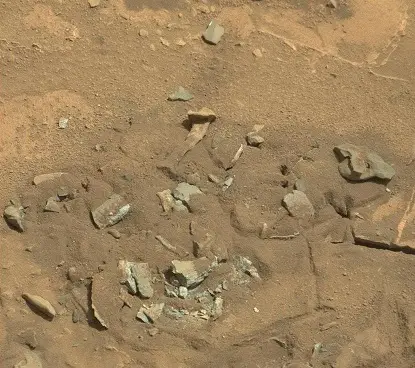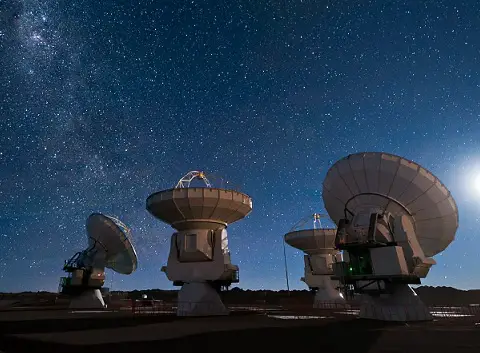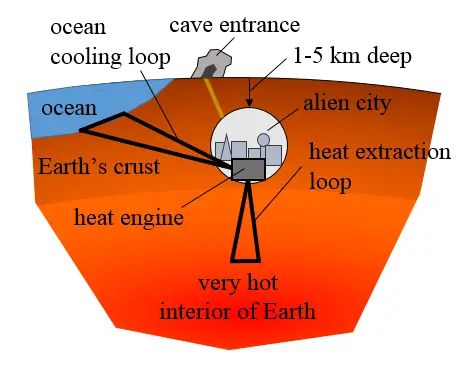Are Aliens Real?

Illustration of Mars rover Curiosity exploring the surface of Mars. Source: NASA/JPL-Caltech
This can be considered one of the great unsolved problems of physics, just like trying to determine the nature of dark matter and dark energy in the universe. The question on whether aliens are real inevitably leads one to resort to physics in an attempt to answer it. You can reason out many related questions as to the existence of aliens using an understanding of physics. You can also use theories based on physics principles and knowledge to infer where the aliens might be or where they could hide. I'm going to do that in this article.
There Should Be Lots of Aliens But ...
The Fermi Paradox famously raises the question on why there are not signs of aliens everywhere. Given that there are billions of stars in our galaxy that are similar to our sun, and have planets orbiting them, just like our sun, it makes sense that there are many technologically advanced civilizations like ours on some of these other planets. Many of these stars are billions of years older than our sun. So by logical extension, some of these other civilizations are much older than ours and therefore much more technologically advanced than ours. Given that some of these civilizations developed interstellar travel, they should have been able to colonize the entire galaxy by now. It would only take a few million years to do so, and relative to a time scale of billions of years, this means that colonization should have happened many times over. Even if just one alien civilization endeavoured to colonize the galaxy and succeeded, they should be everywhere by now. And yet, we don't see any evidence of this. Why not? This is the heart of the Fermi Paradox.
What makes this question so difficult to answer is the lack of information we have on what a very advanced alien race might look like, and what their motivations might be. It's hard enough to predict our own future a few years from now, so imagine how hard it is to predict things hundreds, thousands, or even millions of years from now. What will our technology look like then? And by extension, what would vastly more advanced alien technology look like?
Among our most serious attempts to search for life on other planets is sending rovers to Mars for exploration missions. A rover is shown in the above picture. Their tasks are to explore the surface, look for evidence of water, and for signs of life – microscopic or otherwise. UFO hunters have sometimes looked at photos taken by these rovers and pointed out what appears to be remnants of alien life. In those cases, it is generally assumed by scientists that those are pictures of geographical features on the planet, which due to a combination of light and shadow, look like possible alien remnants. You have to admit, the picture below does look kind of like a thigh bone buried in the Martian sand. But NASA assures us that it's just a bunch of rocks.

Mars rover Curiosity takes picture of 'thigh bone'. Source: NASA/JPL-Caltech/MSSS
Such (mis)interpretations of Martian photos are quite common, and are typically a case of wishful thinking. What we really want to see is a photo of something which is an unambiguous sign of alien life. Fortunately, there is more we can do than just look at martian photos hoping for an alien sighting. Much more.
Alien TV and Radio
A big part of the search for alien life involves scanning the universe for alien signals. The SETI mission, which stands for "Search for Extraterrestrial Intelligence", regularly monitors the sky for alien radio signals. These signals, in physics lingo, are referred to as electromagnetic radiation. Every signal we send wirelessly, such as radio or cell-phone signals, are forms of electromagnetic radiation. The SETI mission is based on the assumption that aliens also communicate with each other using electromagnetic radiation. So what we are trying to do is detect these signals using big antenna dishes, as shown in the picture below.

Source: ESO/José Francisco Salgado (josefrancisco.org)
So far SETI has not detected any alien signals, but the search is ongoing. All we need to do is find one alien signal to prove that we are not alone in the universe.
It is quite reasonable to look for alien transmissions, either in the form of unintentional (or random) TV and radio signals – such as from the alien versions of "I Love Lucy", or from intentional signals sent by aliens with the purpose of finding other intelligent life (such as ours). Marko Horvat fom the faculty of Electrical Engineering and Computing, University of Zagreb, Croatia, discusses the possibility of detecting unintentional signals in depth. He estimates how likely it is for us to detect unintentional alien transmissions based on how many aliens might be out there transmitting, and the length of time they might be transmitting for. Basically, the more aliens are out there transmitting, and the longer is the time that they transmit, the more likely we are to detect them.
Horvat describes an ideal situation where having 200 or 250 alien civilizations transmitting would mean that we would almost certainly detect one of them eventually. But at the same time, it can be very unlikely that we would detect anything at all. It strongly depends on how many aliens there are and how long they transmit for. Having only a few aliens transmitting signals results in a very low probability of us detecting them.
Horvat also argues that aliens likely only transmit signals for a short time relative to the lifespan of their civilization, maybe a few hundred years. They eventually develop superior methods of communication, using perhaps lasers or fiber optics. When this happens they become completely "radio silent" and there is no way they can be detected by SETI! According to Horvat, the probability of detecting intentional signals is negligible or zero, because of how much energy it would take to send signals out into distant space that are strong enough to be detected many light years away. The strength of a radio signal decreases in proportion to the square of the distance from the transmitter. So the strength of a signal at 2 years of distance from the transmitter has 25% the strength of that same signal at 1 light year of distance. This means that a lot of energy is needed to transmit a signal that can be easily detectable at very long distances. The basic argument against this is, why would aliens bother doing this over a very long period of time? Therefore, it is much more reasonable to just assume that aliens would be transmitting signals unintentionally for a few hundred years or so, as they go about their regular business, before becoming completely radio silent.
It seems most likely that virtually all technologically advanced civilizations would go through this unintentional transmission phase as a natural course of their technological evolution. Before this phase they are radio silent because their technology isn't advanced enough yet, and after this phase they are radio silent because they are using better forms of communication, such as lasers and fiber optics (which is what us humans are starting to do right now).
Alien Megastructures
The failure to find aliens by way of detecting their radio signals is by no means the end of the line. There is another way to detect them, based on the laws of thermodynamics, which cannot be avoided no matter how advanced the aliens are. It is a fact that all technology, no matter how advanced, produces waste heat. An advanced alien race, using a very large amount of energy from their sun, would unavoidably produce a large amount of waste heat. It is this waste heat that can be detected using infrared telescopes, which detect electromagnetic radiation in the infrared portion of the electromagnetic spectrum. Jeff Kuhn & Svetlana Berdyugina from the University of Hawaii, published a journal paper in the International Journal of Astrobiology, explaining this in detail. This paper is entitled "Global warming as a detectable thermodynamic marker of Earth-like extrasolar civilizations: the case for a telescope like Colossus." The basic idea is that energy cannot be created or destroyed, and can only change forms. So once you use energy to do work (like power a car), left over energy is created in the form of waste heat, and it is this waste heat that can be detected. But to detect the waste heat of aliens living many light years away, they would have to produce an enormous amount of waste heat. Fortunately for us, this is probably true.
A popular theory is that an advanced alien race would have very large energy requirements, and would therefore use a large percentage of their star's energy to satisfy this requirement. Why would they do this? Because it is the only easily accessible source of almost unlimited energy. For all planets, the ultimate energy source that is available is the home star. For us that would be our sun. Despite all the energy we currently use, there is much, much more untapped energy available from the sun. We currently tap into a tiny portion of that energy using solar panels, collectors, etc. The energy of our sun could easily satisfy all our energy needs now, and in the distant future. Chances are that very advanced aliens are utilizing a large part of the solar energy that is available to them.
Aliens might gather the energy of their home star using a very large array of solar panels, as shown in the illustration below.

Source: Kevin Gill (https://flickr.com/photos/53460575@N03/21983905140)
Just imagine, this huge array of solar panels, called a Dyson swarm, would be contained in an orbit that is millions of miles in diameter. The amount of raw material and engineering know-how needed to create something so enormous in size is mind-boggling! But aliens that are thousands, or millions, of years more technologically advanced than us might just be up to the task. Fortunately for us, it is this type of megastructure that would emit enough electromagnetic radiation in the infrared that we could, in theory, detect with telescopes. As of yet, we have barely scratched the surface on the regions of space to explore. There is still much more work to do in this regard.
Aliens Might Actually Be Everywhere
The answer to the question "Where are all the aliens?" might just be "They are everywhere... we just can't see them". What do I mean by that? I mean that they are hidden from sight. My view is that any aliens that are living in our vicinity, have been there for a very long time, perhaps thousands or even millions of years. It seems logical that any intelligent form of life from other planets that has been around that long must unavoidably have a long-term strategy in place in order to ensure their survival. It could very well be that the best plan for long-term survival for a space-faring alien race is to stay hidden, or else you risk running into other aliens (maybe more advanced than you) who might not be so friendly or empathetic towards your right to exist. The filter for those aliens who die out quickly versus those who stick around for a very long time might very well be, how well hidden they are. The fact that there should be lots of aliens around (according to the Fermi Paradox), but we can't see them, means that they are probably deliberately hiding. So the question then becomes, where?
The way I see it, for an advanced alien race to survive long term while staying hidden, they would have to go to places that allow them to 1) Satisfy their physical needs, 2) Satisfy their energy and material needs, and 3) Take the most economical path to satisfy 1) and 2). Their physical needs would consist of getting the proper nutrition and shelter, having the proper atmosphere to breathe (assuming they need one), and having a gravity similar to that of their home planet. These are things that are readily available in the home world but which would need to be replicated when living somewhere else.
In my view, the most ideal hiding place for an advanced alien race, satisfying 1-3, is underground. We know that there is lots of geothermal heat energy available underground on many planets (which is mostly a result of nuclear decay processes in the planet interior). Geothermal heat energy is very abundant, and on our planet Earth it will last for billions of years. The deeper you go underground, the hotter it is. This heat energy can be used to run a heat engine which supplies the energy needs of the aliens. A heat engine runs based on the laws of thermodynamics, which state that a hot and cold source is all that is needed to run such an engine. Heat from the Earth can be tapped into using a piping loop going many miles deep underground, where it can be hundreds or thousands of degrees. This is the hot source. This loop is basically a type of heat exchanger system that carries heat from deep underground to the heat engine. And cool ocean water can serve as the cold source. This can be similarly tapped into using a piping loop. Again, this loop is basically a type of heat exchanger system that carries heat from the heat engine to be dumped into the ocean. Note that the term "dumped" is another way of saying "dissipated".
So heat from the Earth (the hot source) can be fed into the engine, to run a thermodynamic cycle, and then the waste heat can be dumped into the ocean (the cold source). Alternatively, the waste heat can be dumped into the ground instead of in a large body of water, like the ocean. This might be preferred in fact since oceans can dry up for whatever reason. Either way, this system will run a thermodynamic cycle which can then run an electrical generator (or whatever) which powers the alien city. All heat engines work on a similar system, including the engine in your car or truck, so this is not a new concept. The figure below shows an underground alien city using a heat engine as the power source.

The material needs of the alien civilization can probably be satisfied by mining raw materials from the surrounding earth. This makes sense since the raw material of almost everything we manufacture comes from a mining or earth extraction activity of some sort.
Next comes the question of how they satisfy their physical needs. The enclosed space that is the underground city is an obvious form of shelter, so that's taken care of. If they need to grow food they can create artificial sunlight using their energy source, or alternatively they can synthesize their own food using raw materials found in the Earth (assuming they are advanced enough). They can create their atmosphere inside the enclosed city. And matching the level of gravity from their home world means that the gravity of Earth needs to be the same. But if aliens can produce their own gravity then they might not need to do this, but producing or adjusting gravity would require energy, so at the very least you need a source of energy which the Earth's interior provides.
Lastly, this option of living underground must be the most economical choice available to the aliens. Let's look at why this might be the case. Chances are it's much easier for aliens to find suitable planets in which to live underground than it is to find planets that have the same conditions on the surface as their home world. Just think about how far aliens might have to travel to find planets like their home world. Perhaps many light years. But to find a planet (or moon) that has the same gravity as their home world, and has geothermal energy available, means that they may only have to travel a few light years. For aliens to colonize many different planets (or moons) in the universe in this way means that they probably won't go extinct. It's like an insurance policy against extinction. Aliens can live for hundreds of millions, or billions of years underground, occasionally going to the surface to explore or carry out other activities as required.
In the figure above, I show a cave entrance because it seems logical that aliens would want some way of easily getting to the surface if they need to, if for whatever reason there is something important they need to do, or they just want to explore. However, the problem with entrances in general, located at the surface, is that they can be too easily found. Over a long enough period of time, they can be found. Probably the best place to put the entrances is in remote caves, hidden behind large rocks. These entrances (as well as the underground city itself) would have to be located in geologically stable regions in which there is little reshaping of the Earth's surface, due to tectonic activity. What was a well-hidden cave entrance in the distant past might not be so well-hidden right now, or in the future, due to tectonic reshaping of the Earth's surface.
The picture below shows what appears to be, to some, a cave entrance taken on Mars by the rover Curiosity, in 2015. It sure looks like it could be an entrance, but I think it's a little too noticeable, especially for those eager to find aliens.

Source: NASA/JPL-Caltech/MSSS
Furthermore, for entrances to be functional over a very long time-scale, they need to be at a high enough elevation so that they don't end up underwater at some point.
Putting all this together, the underground cities may need to be close to a large body of water like an ocean (the cold source) and to a suitable entrance location, such as caves, at high elevation. So caves beside a coast, at high elevation, which are geologically stable, could be a good entrance location. In the figure above, I show the underground city as being at a depth of 1-5 km. I figure this is a good depth to be at. You don't want to go too deep since the Earth gets very hot as you go very deep, but 1-5 km deep means you might be comfortably "warm". This is speculation of course since I obviously don't know what aliens find comfortable.
When looking for other planets, aliens would probably skip over planets that already have advanced life, like ours, in order to avoid the risk of conflict. They would probably also try to avoid planets that already have other underground aliens living there, if they knew about them. But this means other aliens might try to set up their home there if they think there is no one else there (even though there might be, living underground). Discovery could lead to conflict. So it's even more important to always stay hidden, since conflict would unavoidably mean letting others know where you are, which makes you vulnerable. So as long as there is no accidental encounter, aliens living underground would prefer to stay hidden. It's the only viable strategy for long-term survival spanning thousands, or millions, of years. So any aliens living among us likely have been here a very long time and arrived long before modern humans showed up.
Aliens living deep underground have the advantage that any planet wide extinction events won't affect them, such as asteroid impacts, supervolcanoes, gamma ray bursts, environmental problems caused by the technologically inferior natives doing stupid things at the surface, etc. They will be protected, in other words. It may be that aliens have to leave a planet eventually if conditions become too dangerous. Billions of years from now, the Earth may be destroyed by the Sun as it transforms into a red giant, which is a process that occurs at the end of its life. The Sun will expand to a size much larger than its present size and might engulf the Earth, causing it to burn up. If this happens, any aliens living underground might not want to stick around.
Living underground offers a great way to observe the natives living on the planet surface. While we are busy scanning the skies for evidence of alien life, it might just be far underneath us, totally undetectable. Now, we might be able to detect underground aliens using the same technology that is used to look for oil underground – that is, using small explosive charges or "thumpers" to produce underground sound waves which reflect off underground objects, and then use this information to detect what's underground. On the other hand, maybe aliens have a way of being invisible to this form of detection, the same way that the Stealth bomber is built to be invisible to radar. It would be very hard for us to find alien civilizations underground, given the much larger size of the Earth relative to an underground alien city, which might only be a few miles across. Where would we even look? It's much easier, and much less expensive, for us to send people to Mars than it is to map out what is underground over the whole surface of the Earth.
In light of everything that's been discussed, the answer to the question, "Are aliens real?", might just be, "Yes, and they are everywhere, on many planets, perhaps underground, either hiding or hibernating." Our best bet to find them here could be to look for signs of waste heat dumped on Earth's surface (by their heat engine), which could actually be at the bottom of the ocean, where waste heat is most easily dissipated, and where it would be hard for us to detect (and probably easy to mistake for something else, like volcanic activity). Keeping this in mind, the alien city would probably not be too large, so as to not generate too much waste heat.
Aliens could also be hibernating in cryogenic preservation deep underground as a way to cope with the very long time scale of thousands, millions, or even billions, of years, and only wake up to perform maintenance activities, or when something interesting happens on the surface. So when their telemetry picks up something unusual or different, they record it, and then maybe go to explore the surface. This means that aliens might have recorded all sorts of key events that have occurred in Earth's long history, such as asteroid impacts, gamma ray bursts, and even the dinosaurs! Think about it, there may actually be recorded footage taken millions of years ago, by aliens, of dinosaurs walking around! You can watch it on the Alien nature special! But seriously, this is not so far-fetched, just like it's possible that aliens are recording our activities right now.
It is not necessarily true that only the most advanced or intelligent aliens will be the ones to survive long-term, throughout the galaxy or universe. Think of it this way, there are animals on Earth that are much more primitive than us, such as insects, and yet they can survive longer than us, much longer, and in harsher conditions. Aliens living underground might actually be seen as "primitive" by other more advanced forms of alien life. There might be aliens so advanced that they don't even have a physical form. They might just be 100% pure consciousness floating around space, living in their own virtual realities, and occasionally observing what else is out there. They too have the ability to stay hidden, just like the underground aliens do. As mentioned, any aliens that are living in our vicinity must have been there for a very long time. Plus, they are obviously hidden, and given the likelihood of their very long existence, being hidden must be a key part of their survival strategy. Being a more "primitive" alien or more advanced alien does not matter in this regard, so long as they are advanced enough to stay hidden and protected long-term, while satisfying their needs. Alien civilizations that aren't very good at staying hidden might only last hundreds or thousands of years, but civilizations that are really good at staying hidden can last millions, or billions of years. Given the age of our galaxy, chances are that these are the civilizations that are in our vicinity.
As discussed, the key to long-term survival of a technologically advanced civilization may be to colonize other planets, while staying hidden and protected. This means that broadcasting our presence to see if there are aliens out there, might not be such a smart idea. Stephen Hawking warned against doing this. We are already sending out radio signals into space anyway as part of our regular telecommunication. But eventually we will move past this and use other types of communication, maybe using lasers or fiber optics. In the meantime, it seems most prudent to not make any deliberate attempts to contact aliens, and instead just keep looking and listening.
The presence of UFOs, as claimed by people and even the military, are not yet enough proof that aliens are here among us, only that their technology might be here among us. Whether this technology is being operated by humans or aliens is the big question. One can speculate that aliens are monitoring us all the time without making the effort to stay completely hidden. This can only mean that they are so much more advanced than us that they do not feel threatened by humans at all, and are perfectly content watching us, even if we suspect they are there. But at the same time they will only advertise their presence to the extent that our society will not be disrupted, since that could have broader implications and consequences that aliens want to avoid.
Return to Physics Essays page
Return to Real World Physics Problems home page
Free Newsletter
Subscribe to my free newsletter below. In it I explore physics ideas that seem like science fiction but could become reality in the distant future. I develop these ideas with the help of AI. I will send it out a few times a month.